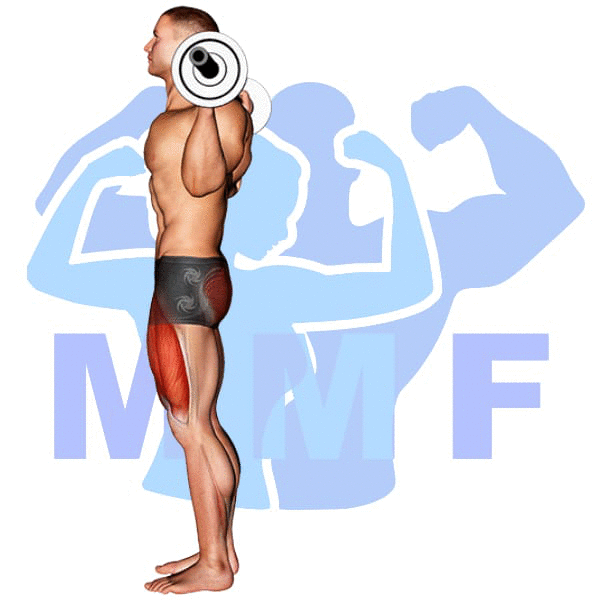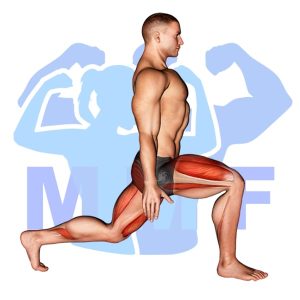Do you struggle to tone your lower body and feel like you’ve hit a plateau in your fitness journey? Are you tired of doing the same leg exercises over and over again with minimal results? The solution may be simpler than you think. Many people overlook the importance of incorporating the barbell reverse lunge into their workout routine. If you’re not seeing the results you want, it’s likely due to a lack of variation in your exercises. But don’t worry, by adding the barbell reverse lunge to your fitness plan, you can break through that plateau and see real progress. In this post, we’ll dive into how to properly execute the barbell reverse lunge and why it’s the game-changing exercise your lower body has been missing.
Barbell Reverse Lunge Summary
- Primary Muscles: Gluteus Maximus
- Secondary Muscles: Adductor Magnus, Quadriceps, and Soleus
- Equipment: Barbell
- Mechanics Type: Compound
- Force: Push
- Utility: Basic or Auxiliary

Barbell Reverse Lunge Instructions
- Set up for your reverse lunges by loading a bar with a rack and placing the bar on your back up by your shoulders just like your are setting up for squats.
- Un-rack your bar and setup so that you have room to step back into a lunge.
- Begin with your feet directly under your hips, then step back with one leg about twice the length of your normal walking step.
- Now, lunge down with your back knee until it gets close to the ground but does not touch.
- Finally, press up with enough force that you can step your back foot back to your starting stance.
- Repeat by alternating with each leg until you do 8-12 reps on each side.
Video Tutorial
Barbell Reverse Lunge Muscles
Target (Agonist)
Synergists
- Adductor Magnus
- Quadriceps
- Soleus
Dynamic Stabilizers
Stabilizers
- Erector Spinae
- Gluteus Medius
- Gluteus Minimus
- Levator Scapulae
- Obliques
- Quadratus Lumborum
- Tibialis Anterior
- Trapezius – Middle
- Trapezius – Upper
Antagonist Stabilizers
- None

Benefits of Barbell Reverse Lunge
The Barbell Reverse Lunge is an effective exercise for strengthening the Gluteus Maximus, one of the major muscles of the hip. This exercise promotes improved posture, balance and stability, while also helping to increase strength and power in the lower body. Additionally, it helps to increase hip mobility and flexibility, while targeting the Gluteus Maximus muscle to build strength and endurance. Performing Barbell Reverse Lunges regularly can help to improve overall performance, reduce the risk of injury, and promote better body mechanics.
Tips for Performing Barbell Reverse Lunge
Before we get into the tips, it’s important to remember that the barbell reverse lunge is an advanced exercise and should only be attempted by those who have built up a base level of fitness. It’s also important to maintain proper form throughout the exercise to ensure maximum benefit and avoid injury. With that in mind, let’s look at some tips to help you make the most of the barbell reverse lunge.
- Balance Your Bar So That You Can Work Both Sides Equally.
- At All Times Utilize Complete Range Of Motion. Using a total range of motion you can ensure that you strain your total muscle and that you keep your flexibility.
- You Should Make Sure That You Schedule Rest Days. When you still want to exercise, instead of recovery you could incorporate into your routine with aerobic exercise. Only understand to allow your muscles to repair, healing is how your muscles grow.
- Slow Down All Movement To Just Under 6 Seconds For Each Contraction And The Same For The Extension, To Boost Your Training. So that you will build mas you want to maximize the amount of time under strain of your primary muscle tissue. Going slower your lift will increase the amount of time under stress. Frequent studies have found that about 5 seconds of extension and contraction is the ideal time that provides optimum benefit for creating muscle size. You should use this method on occasion, but not every time you exercise.
Benefits and Tips Video
Frequent Mistakes To Avoid
It’s important to remember that the Barbell Reverse Lunge is a great exercise for those who want to get fit, but it’s important to avoid making certain mistakes. Below is a list of some common mistakes to avoid when performing this exercise.
- Stop Yourself From Using To Little or Too Much Resistance. Too little, and you will not be sufficiently employing your target muscles, too much, and it will lead to cheating. Be sure you focus on your proper movement.
- Avoid The Urge To Trai Alone. Your companion is usually an incredible motivator. Your training partner can certainly be also valuable spotter.
- Don’t Allow Yourself To Cheat. In most cases, cheating is utilizing momentum instead of the force of your main muscle tissue. Occasionally, a little cheating on your final rep can be beneficial to overload your muscle, although not for more than one or two reps.
Find More Barbell Exercises Here
Variations and Complementary Exercises
In order to mix up your workout and target the same muscles as the Barbell Reverse Lunge, try these variations, complementary, or alternative exercises:
Barbell Walking Lunge

Barbell Walking Lunge is a great complementary or alternative exercise to the Barbell Reverse Lunge. The Barbell Walking Lunge involves lunging forward with one leg while holding a barbell, alternating legs with each step. This exercise works the same muscles as the Barbell Reverse Lunge, but also adds a dynamic element, as the lunge is taken in a forward direction. The Barbell Walking Lunge also allows you to move more freely and quickly, as opposed to the stationary Barbell Reverse Lunge. Both exercises are great for strengthening the lower body and increasing overall strength and stability.
Dumbbell Lunge

The Dumbbell Lunge is a great complementary exercise to the Barbell Reverse Lunge. It is similar in that it works the same muscles and requires similar balance and coordination. However, the Dumbbell Lunge requires more core stability and balance due to the instability of the dumbbells. Additionally, the Dumbbell Lunge can target different areas of the leg muscles, allowing for greater diversity and a more well-rounded leg workout. The Dumbbell Lunge can also be used as an alternative to the Barbell Reverse Lunge when equipment is limited or if you want to focus more on unilateral training.
Dumbbell Rear Lunge

The Dumbbell Rear Lunge is an excellent complementary exercise to the Barbell Reverse Lunge. It is a unilateral exercise, which means it works each leg separately, while the Barbell Reverse Lunge is a bilateral exercise that works both legs at the same time. The Dumbbell Rear Lunge focuses on the glutes and hamstrings and helps to target muscles in the posterior chain that can be neglected with the Barbell Reverse Lunge. It is a great alternative for those who have difficulty maintaining proper form or balance with the Barbell Reverse Lunge. It can also be used to increase the intensity of a workout by adding weights, as well as incorporating different variations such as walking lunges.
Check Out These Top Barbell Exercises
Dumbbell Walking Lunges

Dumbbell Walking Lunges are a great alternative or complementary exercise for the Barbell Reverse Lunge. This exercise, which can be done with or without weights, is a great way to strengthen your legs, glutes, and core. It involves stepping forward with one foot while keeping your back straight and keeping your weight on your front heel. As you lunge forward, be sure to keep your chest up and your core engaged. When returning to the starting position, drive through the heel of the front foot to stand up. This exercise is a great way to add more intensity to your leg workout and build strength and stability.
Lunge

The Lunge is a popular exercise that is often used as an alternative or complementary exercise to the Barbell Reverse Lunge. It is a compound, multi-joint exercise that involves a deep knee flexion and hip extension. It requires significant core stabilization and balance. It works the quadriceps, glutes, hamstrings, adductors, and core muscles. Compared to the Barbell Reverse Lunge, the Lunge provides more overall muscle activation and a greater range of motion in the lower body. Additionally, it can be done with bodyweight or with weights for added intensity. The Lunge is a great way to build strength, power, and mobility in the lower body.
Rear Lunge

Rear Lunge is a great complementary or alternative exercise to the Barbell Reverse Lunge. It works the same muscles, with the focus being on the quads and glutes, but with a different motion. Instead of stepping backwards, you step out to the side and lower into a lunge. You can also add a twist to it to work your core as well. This exercise can help you build strength and stability in your lower body, which is essential for any type of leg exercises. Rear lunges are an excellent addition to any leg workout, whether you’re a beginner or an advanced lifter.
Find More Glutes Exercises Here
Opposing Complementary Exercises
To further enhance the results of the Barbell Reverse Lunge, it is beneficial to complete exercises that target the opposing muscle groups. These exercises will help to strengthen the muscles that are not used during the Barbell Reverse Lunge and can help prevent injury. The following exercises are great options to complement the Barbell Reverse Lunge:
Dumbbell Half Squat

The Dumbbell Half Squat is a great complementary exercise to the Barbell Reverse Lunge. It works the same primary muscle groups, but in an opposing manner. While the Reverse Lunge focuses on the glutes, hamstrings, and quads, the Dumbbell Half Squat focuses on the quads, calves, and core. This combination allows for a complete lower body workout that works both sides of the muscles equally. With this pairing of exercises, you can ensure that your lower body is getting an effective workout with full range of motion.
Dumbbell Squat

The Dumbbell Squat is an excellent exercise for strengthening the lower body muscles. It works the quads, glutes, and hamstrings, providing an intense workout. This exercise is a great complement to the Barbell Reverse Lunge, as it works the opposing muscle groups. By alternating between these two exercises, you can target all of the major muscles in the lower body and build strength and stability throughout.
Lever Full Squat (Machine)

The Lever Full Squat (Machine) is an excellent complement to the Barbell Reverse Lunge exercise, as it works the opposite muscle group. The Lever Full Squat works the quadriceps, hamstrings, and glutes, while the Barbell Reverse Lunge works the hip flexors, abductors, and glutes. This combination of exercises gives a comprehensive workout for the lower body, as both exercises work different muscle groups and use different motions. Furthermore, the Lever Full Squat helps to balance out the workout by providing a lower body workout that is more focused on developing strength, while the Barbell Reverse Lunge helps to develop stability, balance, and coordination.
Step Up Your Leg Day with Barbell Reverse Lunges
When it comes to leg day, the barbell reverse lunge is a great exercise to add to your routine. It targets multiple muscles in your legs, including your quads, hamstrings, and glutes. It’s also a functional exercise, meaning it mimics movements we use in daily life, such as walking and climbing stairs. By adding barbell reverse lunges to your workout, you can improve your overall leg strength and stability, as well as increase your balance and coordination. So, next time you hit the gym, consider steping up your leg day with this challenging yet effective exercise!
References: Wikipedia | ExRx.net | PubMed.gov | Comprehensive List of Glutes Barbell Exercises




